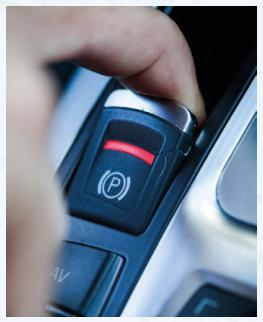This issue’s Q&A article answers three questions about parking brakes.


This issue’s Q&A article answers three questions about parking brakes.
I plan to get a car. I realise that many new cars today have electronic parking brakes. It appears to me that traditional handbrakes are safer since they are manually operated and not subject to electrical or electronic failures.
Also, in case I have to perform an emergency stop, it is easier for my hand to grab and yank the handbrake than for my fingers to seek out and fiddle with a small lever to operate the electronic parking brake. Are handbrakes safer?
More and more car makers are opting for electronic parking brakes because it frees up space in the aisle between the front seats.
From a safety point of view, the parking brake should not be relied on for emergency stops. You should instead slam on the brake pedal with all your might and maintain the pressure until the car is stationary.
Your hands should be on the steering wheel, so you can steer the car away from danger while braking hard (possible only with cars which have anti-lock braking systems). Having one hand on the parking brake lever will compromise this crucial manoeuvre, which can make a difference between life and death.
Handbrake turns, admittedly, are easier to do with a physical lever. But unless you are a professionally trained bodyguard or a rally driver, you should not attempt handbrake turns and especially not on public roads.
The parking brake is what its name suggests – to stop a vehicle from rolling off when parked. For this role, an electronic system is better since it will always apply the correct pressure – something that is not always the case with a hand-operated lever.
As for failures, most electronic or electrical systems in a car have built-in fail-safes. That is to say, if a component fails (or in some cases, is about to fail), the driver will be warned. You do not get that with a conventional handbrake.
AN ELECTRONIC PARKING BRAKE SYSTEM FREES UP SPACE IN THE AISLE BETWEEN THE FRONT SEATS.

More and more cars put their parking brakes at the driver’s fingertips, and some cars can even engage/disengage their parking brakes automatically.
I recently purchased a second-hand 2008 Toyota Camry. This car comes with a foot-operated parking brake instead of a handbrake. On a slope, I am able to manage a car from going backwards using the typical handbrake and accelerator. How do I do so with a footbrake? I have been taught to use only one foot for the brake pedal and accelerator pedal.
With an automatic transmission, the engine is always coupled to the driven wheels as long as the transmission lever is in one of the drive modes (whether forward, reverse or manual- select). Hence, the car will not roll backwards on a slope when you release the brakes. It may either creep uphill or stay stationary – unless the slope is very steep.
Even then, the transmission provides enough torque to delay a backslide. You should put your left foot on the brake pedal and release it as you apply acceleration with your right foot.
For cars with a robotised-clutch or double-clutch gearbox, the clutch is disengaged whenever the car is at a standstill, even if the gear selector is in Drive.
On a slope, the car could roll back. So you must hold the brake pedal with your left foot and release only as you accelerate to move off. What you should never do with these transmissions is release the brakes and let the transmission hold the car on the slope. This will cause the clutch to slip. If this happens regularly, it will lead to premature wear.
There is no rule that says you cannot use your left foot for the brake pedal.

How safe is it to leave a car’s automatic transmission in Park (P) position without engaging the parking brakes?
If there is no mechanical flaw in the car, it should not roll away in Park. But if the auto gearbox is defective, leaving the lever in P may not lock the vehicle in position.
There are instances when a transmission’s D (Drive) or R (Reverse) does not engage either. This may be a linkage problem. The same thing could happen in P (Park), rare as it may be.
So to be safe, it would be best to engage your car’s parking brakes and turn o the engine, even if you are just leaving the vehicle momentarily.
PHOTOS & ILLUSTRATION 123RF.COM























